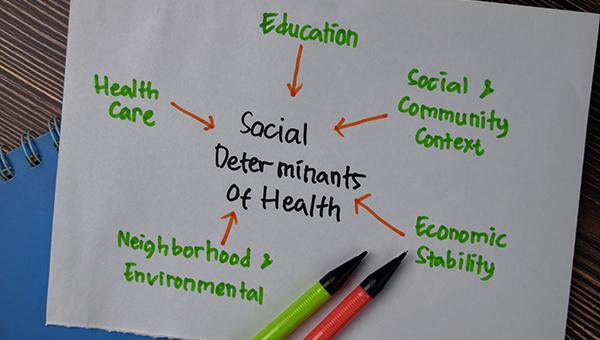Social Determinants of Health Drive Racial CVD Risk Differences
In the US, healthcare improvements are critical for people with lower income and education, the lead study author says.

Over the past 20 years, disparities in cardiovascular risk factors have persisted between Black and white adults in the United States, likely being driven by social determinants of health, according to new data.
This isn’t the first study to draw connections between broader societal disparities and heart health, and racial/ethnic differences in cardiovascular risk factors have been known for a long time. Growing awareness has even prompted cardiology journals to take stock of structural racism in the field.
Yet this latest study, published online this week in JAMA, stands out for its scope, authors say.
Ours “is the first study to report that body mass index, systolic blood pressure, and hemoglobin A1c were persistently higher in the Black population compared with the white population after adjustment for important social determinants of health, such as education, income, housing, employment, health insurance, and access to healthcare. Other unmeasured social determinants, such as neighborhood and physical environment, access to healthy foods, and social integration, were not included in this analysis but seem likely to play an important role in racial and ethnic differences.”
Speaking with TCTMD, lead author Jiang He, MD, PhD (Tulane University School of Public Health and Tropical Medicine, New Orleans, LA), said that it is clear that cardiovascular risk factors “reflect the socioeconomic standards, so we need to improve healthcare for the entire population, especially to people with low income and low education.”
He argued that “everyone” is responsible for paying attention to these issues and making a change. “Individuals, community, government, and the entire nation really need to work on this to improve cardiovascular health,” He said.
Commenting on the study for TCTMD, Sadiya S. Khan, MD (Northwestern University Feinberg School of Medicine, Chicago, IL), said in an email that it “is an important reminder of adverse patterns in cardiometabolic health in the population that precede the pandemic. I am concerned that we may see worsening patterns given early reports of increased weight, poor control of risk factors, and missed appointments for preventive care during the pandemic.”
As such, Khan would like to see changes in health policy that increase insurance access and decrease medication costs more broadly, she said. “There is no reason that medication for blood pressure, diabetes, and cholesterol shouldn’t be free. This would eliminate a large proportion of preventable cardiovascular disease deaths.”
NHANES Findings
For the study, the researchers included more than 50,000 US adults from the National Health and Nutrition Examination Surveys (NHANES) with a mean age ranging from 49.0 to 51.8 years and the proportion of women from 48.2% to 51.3%.
Between 1999-2000 and 2017-2018, overall body mass index (BMI) and hemoglobin A1cincreased while mean serum total cholesterol and smoking decreased. Mean systolic BP followed a U-shaped pattern, decreasing from 123.5 mm Hg in 1999-2000 to 120.5 mm Hg in 2009-2010 but then going up to 122.8 mm Hg in 2017-2018.
Age- and Sex-Adjusted Risk Factors Over Time
|
|
1999-2000 |
2017-2018 |
|
Mean BMI, kg/m2 |
28.0 |
29.8 |
|
Hemoglobin A1c |
5.4% |
5.7% |
|
Mean Serum Total Cholesterol, mg/dL |
203.3 |
188.5 |
|
Smoking |
24.8% |
18.1% |
Participants with at least a college education and those with greater family incomes reported fewer cardiovascular risk factors. When broken down by racial and ethnic groups, non-Hispanic Black participants reported consistently higher BMI, systolic BP, and hemoglobin A1c as well as lower total cholesterol compared with non-Hispanic white participants. Additionally, compared with white participants, Hispanics had a higher mean BMI and hemoglobin A1c but were less likely to report smoking.
Overall age- and sex-adjusted 10-year cardiovascular disease risk decreased from 7.6% in 1999-2000 to 6.5% in 2011-2012 and plateaued from there.
The age- and sex-adjusted 10-year cardiovascular disease risk was 1.4% higher for non-Hispanic Blacks than non-Hispanic whites from 1999-2008 and 2.0% higher from 2009-2018. However, these differences narrowed to -0.3% and 0.7%, respectively, after accounting for education, income, home ownership, employment, health insurance, and healthcare access.
Similarly, 10-year cardiovascular disease risk was 0.8% higher for Hispanic versus white individuals in 1999-2008 and 0.7% higher in 2009-2018. But after considering the various social determinants of health, the difference actually favored Hispanics, whose risks were 1.3% and 0.7% lower in the two time periods.
‘Health Issues Are Not Isolated’
“While it is not a surprise that obesity, diabetes, and hypertension have increased over this study period and significant racial disparities persist, I was surprised by the persistently high prevalence of smoking,” Khan commented, noting that while smoking did decline over time, even in the later study period “nearly one in five adults” reported smoking.
“Research such as this is critical to set national policy,” she said, but gaps remain. “Too often Hispanic and Asian subgroups are not adequately represented, and the heterogeneity in these groups require disaggregation.”
The researchers acknowledge that the study findings were limited in other populations since the Pooled Cohort Equations have not been validated in Hispanics or Asians. “In addition, Hispanic and Asian participants were aggregated into single categories although there were heterogeneities within these racial and ethnic groups,” they write.
“We do hope the health policy makers pay attention to this [as] a lot can be solved by changing health policy,” He said. For now, he recommended a greater clinical focus on reducing weight, diabetes, and blood pressure since “many cardiovascular disease risk factors become worse [over time].”
Additionally, he would also like to see agencies like the US National Institutes of Health and other research funding organizations “really start to pay attention to social determinants of health, because a lot of health issues are not isolated.”
Yael L. Maxwell is Senior Medical Journalist for TCTMD and Section Editor of TCTMD's Fellows Forum. She served as the inaugural…
Read Full BioSources
He J, Zhu Z, Bundy JD, et al. Trends in cardiovascular risk factors in US adults by race and ethnicity and socioeconomic status, 1999-2018. JAMA. 2021;326:1286-1298.
Disclosures
- He and Khan report no relevant conflicts of interest.





Comments